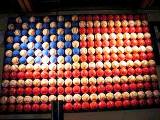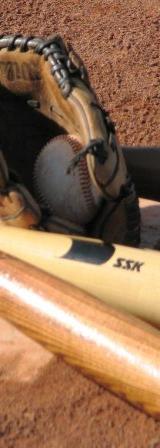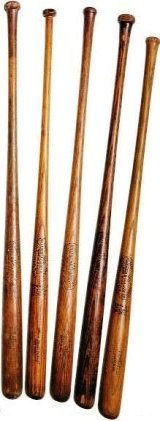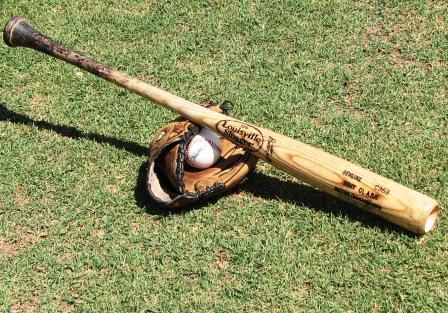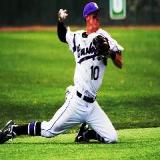|
The Double Cutoff ~ Sheer Poetry In Motion!
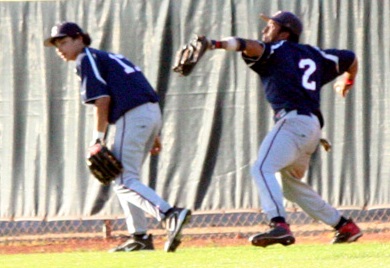
The double cutoff is used in situations where the baseball has gotten through, past, between or over an outfielder. One of the many essential skills for a defense, no matter what the level or age.
A big brother to the single cutoff, the basic concept is the same, it is just played out at a greater distance from the infield, using two infielders working together in sync and the possibilities of more decisions needing to be made and communicated.
In the photo, the center fielder and the right fielder have converged on a ball hit in the right center gap. As you can see, they have run the ball down, almost at the warning track.
The center fielder has the baseball and is in the process of making the first throw on this play. As there are two outfielders together on this particular play, the centerfielder has made the call that he has the ball, and the rightfielder has given him room.
Let's take a look at the rest of this relay, the players responsibilities and the concept behind it all.
Double Cutoff ~ What Makes It Different?
Once the ball gets past the outfielders, the throwing distance has increased measurably for the defense.
The shortstop and second baseman must spring into immediate action, so they can get into position to line up the outfielders throw, as well as make the relay throw to where ever it needs to go.
For younger players, I have the lead infielder keep going out towards the outfielder, until the outfielder picks up the baseball.
Our high school players make the decision on where to set up, based on the strength of the outfielders arm. You want the strongest arm making the longest throw. If the outfielder has the strongest arm, the infielders set up sooner. If not, they go out further.
The trailing infielder sets up 15-20 feet behind the lead infielder, and is there to field any throw which goes over the first players head, or short hops him.
If the lead player has to jump to catch the ball, or has to short hop the ball, he steps out of the way and lets the second player make the play.
As the lead player is running to set up, he needs to be yelling "Hit Me" or "Ball", what ever term you like to use. It is doubly important in this situation to yell, as the outfielder almost always has his back to the infield.
With the verbal communication, he is able to turn and throw to the voice, saving precious steps.
Along with yelling, the lead player needs to have both arms extended above his head, providing a good target for the outfielder.
The third baseman, or the catcher yells to get the players set up in line to the base the throw will be coming to.
We're now on line and set up, what happens next?
Below are the double cutoff and individual position responsibilities.
- Balls from the left field foul line to straight away center field, no runners on base.
- Lead is the shortstop, second baseman trails, first baseman drops in behind the batter/runner and follows him into second base, pitcher backs up 3B.
- Balls to right center to the right field foul line, no runners on base.
- Lead is the second baseman, shortstop trails, first baseman drops in behind batter/runner and follows him into second base, pitcher backs up 3B.
- Balls from left field foul line to straight away center field, runner on first.
- Lead is the shortstop, second baseman trails, first baseman comes into the infield grass and becomes the infield cut, pitcher goes to a spot in foul territory, half way between third base and home to read where the ball will be thrown, then backs up either home or third accordingly, third baseman covers third and the catcher covers home plate and makes the call as to where the throw will be going. If it will be home, catcher needs to get cutoffs lined up.
- Check out all the cutoffs at double cutoff diagrams.
Double Cutoff Tips ~ From the Dugout
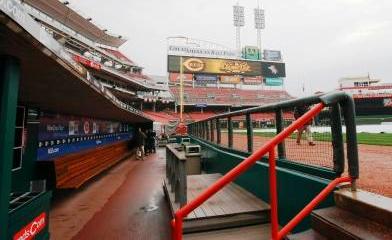
- The middle infielders sprint into position for the cutoff.
- First player must yell loudly to provide the outfielder with a audible target, as most often their back is to the infield.
- As the ball is released, the infielder anticipates where the ball is headed and moves his feet to get in position for his throw. Start turning your body as you make the catch, already in motion towards the target, providing momentum to the throw.
- The lead man only cuts the ball if it is an easy catch. Should it short hop him, or be so high he has to jump to reach it, let it go. It now becomes the cut for the second cutoff man.
- The trailing player must be prepared to make this cut from the start. If they are ready, it will be a smooth transition and the possibility for an out is still possible.
- The first baseman trailing the runner can sometimes lead to a backside out, off the cutoff.
- With a runner on first, the pitcher goes and sets up along the third base line, in foul territory, halfway between third base and home plate. He is there until he determines which base the play will actually be made to, he then sprints into position to back up that base.
Creating A Team Pride Atmosphere About Your Cutoff Systems
For a team to execute the single and double cutoffs efficiently, they need a complete understanding of all the component parts and how they go together.
Taking the time at the beginning to walk through each players responsibilities, with the entire team, can reap great dividends later on.
Once the players know it is important to you, it will become important to them. That is not to say that there won't be the occasional bad throw, or dropped relay; but those mistakes become fewer and farther between when the entire concept is understood by the group.
At The Heart Of Every Defense Is Communication!
Communication is the absolute key! It starts as soon as the ball comes off the bat. Recognition that the ball hit will require a double cut, the middle infielders start yelling double cut, as they sprint to get into position.
At the same time the pitcher is moving into position, the 3B and catcher are determining which base the play will be going to, and start getting the cutoff tandem lined up accordingly.
As it all unfolds, the double cutoff becomes a thing of beauty, sheer poetry in motion.

When It Results In An Out, Whether The Lead Or Trail Runner, It Is A Tremendous Boost To The Defense, One Worth All The Time And Repetitions It Took In Practice, To Make It Happen In A Game.
return from double cutoff to the ole ballgame.com
|
Individual Personal Instruction Available - Tucson Az and Surrounding
What Can I Do Today That Takes Me One Step Closer To My Mission!
|


